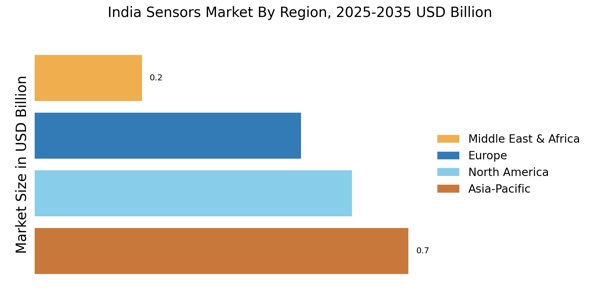Rising Demand for Automation
The increasing demand for automation across various industries is a pivotal driver for the India Sensors Market. As sectors such as manufacturing, automotive, and healthcare seek to enhance efficiency and reduce operational costs, the adoption of sensors becomes essential. For instance, the automotive industry is projected to witness a substantial growth rate, with an expected increase in sensor deployment for applications like advanced driver-assistance systems (ADAS). This trend indicates a broader shift towards smart manufacturing and Industry 4.0, where sensors play a crucial role in data collection and process optimization. Consequently, the India Sensors Market is likely to experience a surge in demand as companies invest in automation technologies to remain competitive.
Emergence of Smart Agriculture
The emergence of smart agriculture practices is transforming the agricultural landscape in India, thereby driving the India Sensors Market. The integration of sensors in farming operations enables real-time monitoring of soil conditions, crop health, and weather patterns, leading to improved yield and resource management. The market for agricultural sensors is projected to grow significantly, with an increasing number of farmers adopting precision farming techniques. This shift not only enhances productivity but also promotes sustainable farming practices. As a result, the India Sensors Market is poised to expand as agricultural stakeholders recognize the value of sensor technologies in optimizing their operations.
Growth in Consumer Electronics
The burgeoning consumer electronics sector is a notable driver for the India Sensors Market. With the proliferation of smart devices, including smartphones, wearables, and home automation systems, the demand for various sensors such as accelerometers, gyroscopes, and temperature sensors is on the rise. Market data suggests that the consumer electronics segment is anticipated to grow at a compound annual growth rate (CAGR) of over 10% in the coming years. This growth is fueled by increasing disposable incomes and a shift towards smart living solutions. Consequently, the India Sensors Market is likely to benefit from this trend, as manufacturers seek to incorporate advanced sensor technologies into their products.
Government Initiatives and Policies
Government initiatives aimed at promoting technological advancements and manufacturing capabilities significantly influence the India Sensors Market. Policies such as the Make in India initiative encourage local production of sensors, thereby reducing dependency on imports. Furthermore, the government's focus on smart cities and infrastructure development necessitates the integration of sensors for efficient resource management and urban planning. The allocation of funds for research and development in sensor technologies also indicates a commitment to fostering innovation. As a result, these initiatives are expected to bolster the growth of the India Sensors Market, creating opportunities for both established players and new entrants.
Advancements in Healthcare Technology
Advancements in healthcare technology are significantly impacting the India Sensors Market. The growing emphasis on remote patient monitoring and telemedicine has led to an increased demand for medical sensors that can track vital signs and health metrics. Market data indicates that the healthcare sensor market is expected to grow at a robust pace, driven by innovations in wearable devices and diagnostic equipment. These sensors facilitate timely interventions and improve patient outcomes, aligning with the broader trend of personalized medicine. Consequently, the India Sensors Market is likely to see substantial growth as healthcare providers and technology companies collaborate to develop cutting-edge sensor solutions.

















Leave a Comment